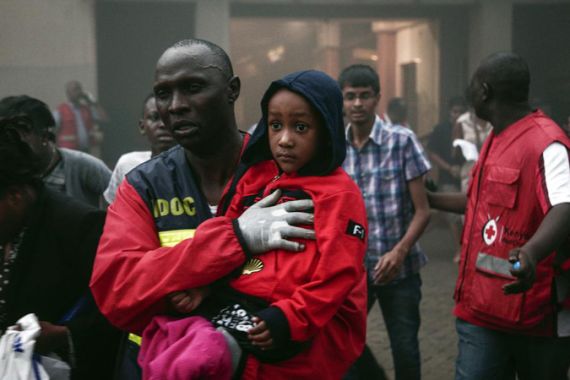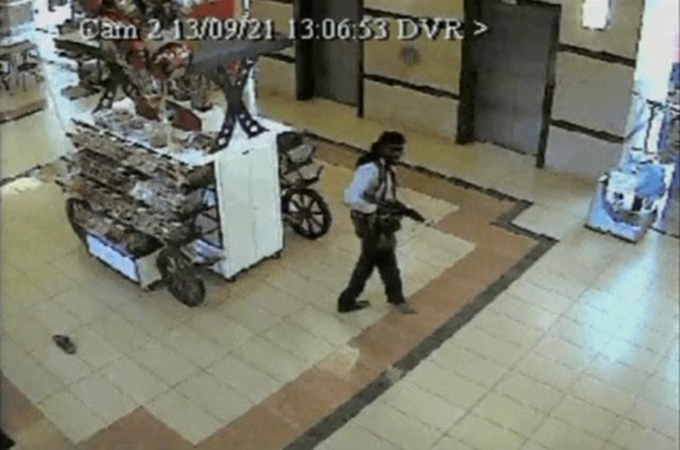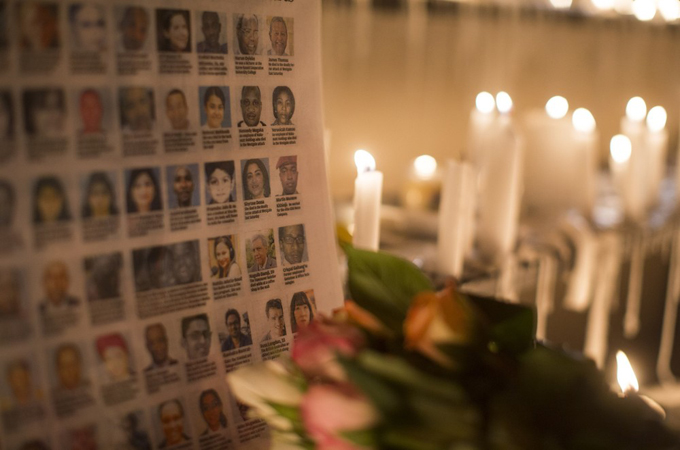Westgate questions and Kenya’s misled media
NYPD report sheds light on mall attack misinformation, while new laws bring the press in line.

Nairobi, Kenya –The world looked on as al-Shabab gunmen stormed the popular Westgate Mall on September 21 in a brazen attack for what the group said was retaliation for Kenya’s military operations in Somalia.
As the crisis unravelled over the next three days, Kenyans’ despair turned to puzzlement as increasingly befuddled government ministries and officials contradicted each other over the situation.
Now a recent report made public by the New York Police Department’s anti-terrorism unit has challenged the Kenyan government’s version of events during the Westgate siege.
The NYPD report suggests the assailants may have fled from the scene of the attack, which killed at least 67 people and wounded more than 200 others.
“It is unknown if the terrorists were killed or escaped the mall,” the report said. “A major contributing factor to this uncertainty was the failure to maintain a secure perimeter around the mall.”
The investigation also questioned the actions of the armed forces before President Uhuru Kenyatta declared an end to the siege 78-hours later.
While the report raises questions over the state’s security apparatus and its ability to handle such crises, traumatised Kenyans may never get the answers they want from their government about what really happened.
That's the million-dollar question. Were the terrorists killed or did they escape? As a cop, I'm very sceptical of any claims unless I see some proof.
Kenya’s oft-described “vibrant” media, meanwhile, has since been hamstrung by the recent passing of tighter press laws, and a special commission promised by the government to investigate the attack has yet to materialise.
Killed or escaped?
Using open source information and relying heavily on CCTV footage from within the mall, investigators from the NYPD’s Joint Terrorism Unit pieced together a timeline of events from the attack.
The report found that plainclothes first responders may have created problems in distinguishing attackers from security personnel. Poor coordination between police and the military also led to the death of one police officer and the wounding of another in a friendly-fire incident.
It also found the attackers were aware of CCTV cameras and made conscious but erratic attempts at distinguishing Muslims from non-Muslims during their shooting spree.
Among the most startling findings, investigators said they believed only 12 hours into the 78-hour siege, the four gunmen had disappeared. Security footage reviewed by the investigators showed the attackers waiting in a supermarket storeroom until the CCTV camera was tilted away by one of the men, and they are not seen again.
Based on the type of weapons, amount of ammunition, the lack of martyrdom videos and official announcements by al-Shabab, the report concluded the perpetrators may have intended to leave the mall after the attack.
“It appears the mission of this attack was to conduct a high-profile attack by inflicting as many casualties as possible in a short period of time, and then possibly escaping during the ensuing confusion,” the report said.
In a press conference last week, detective Kevin Yorke said he was sceptical of Kenyan government claims that all four attackers were dead.
“That’s the million-dollar question. Were the terrorists killed or did they escape? As a cop, I’m very sceptical of any claims unless I see some proof,” he said. “To put it politely, the Kenyan government has been vague and contradictory in their explanations.”
Animal DNA?
The report also states that a DNA sample supposedly taken from the remains of one of the attackers was actually animal meat from the supermarket’s butchery.
 |
| A gunman walks next to a stall during the attack [Reuters] |
Kenyan officials have since rejected the report, saying it was based only on open source and second-hand information.
“We can confirm that all attackers were killed in the building,” said Kenya Defence Force spokesperson Major Emmanuel Chirchir at a press conference last week.
He also posted on Twitter defending the government’s view that all attackers were dead.
“It’s not about Westgate … it’s about representing facts … The terrorists were killed and bodies burnt beyond recognition,” he said.
However, three months after the Westgate attack, the Kenyan government has failed to produce its own report into the incident, or establish a Westgate commission that was promised by the president in October.
Lucas Barasa, a local journalist who covered the Westgate attack for Kenyan newspaper the Daily Nation, is also sceptical that Kenyan authorities will establish a commission.
“It [the commission] will not happen. It will not happen in Kenya,” he said. “The victims were forgotten immediately, the dead were buried. That’s what happens in Kenya.”
Misleading the media?
The Kenyan authorities have also come under criticism for the way they distributed official information during the attack.
Much of the information about the number of attackers and number of dead or missing appeared contradictory to other sources such as the Kenya Red Cross. Even different government agencies released conflicting details.
“They were not giving any useful information because they were also confused,” said Barasa.
“The inspector general was also at the scene, he wanted to go inside but he was blocked by security personnel for security reasons, he was told he could be shot. So they were also in the dark. They didn’t know what was happening,” he said.
They wanted to control information. You know some of the information was not in their favour so they wanted to control what was coming to the public.
As the crisis moved into its final days, the increasingly conflicting information provided by the government caused frustration among Kenyans.
“The government had two centres of information. They were giving information from two parallel sources. So we were getting two conflicting reports from the authorities,” said Barasa.
Barasa said authorities also pressured journalists to fall in line and report only the official government death toll and updates. A day after the siege began the authorities moved the media out of the Westgate area and cordoned them off in the car park at a nearby Hindu temple, out of view of the mall.
“They wanted to control information,” said Barasa. “You know some of the information was not in their favour so they wanted to control what was coming to the public. So when they realised that, they started pushing journalists from closer to the scene.”
Despite government pressure, however, the Daily Nation newspaper broke the story of a botched police and army operation in which a police commander was wounded and a GSU police officer killed in a friendly fire incident with army forces.
A few days later Dominic Wabala, a journalist at another local newspaper The Star, published a story of Kenya Defence Force soldiers caught looting shops in the mall on CCTV footage. Expecting to see evidence of the massacre, Wabala was shocked at what he saw instead unfolding on the security video.
“It was appalling, I couldn’t believe what I was seeing and what was being done,” he said. “What was of concern to me is that instead of seeing evidence of the massacre and all that … there was this apparent evident looting of some of the things within Westgate.”
The revelation sent shockwaves throughout Kenya, the country’s highly respected security forces had now been implicated in the theft of goods from the Westgate mall.
“That created bad publicity for the government, bearing in mind that during the first few hours and days of the incident that they had been trying to manage the flow of information, which in the end backfired,” he said.
 |
| Photographs of the Westgate victims [Getty Images] |
‘Anti-press legislation’
Since the Westgate attack, freedom of the press has been further stifled by new media laws passed by the Kenyan parliament in December.
The amendments to the Kenya Information and Communication Act and the Media Council Act will slap fines on journalists of up to 500,000 Kenyan shillings (US$5,500) and 20 million Kenyan shillings (US$230,000) for media organisations who fall afoul of a code of conduct enforced by a government-controlled media board.
US-based Committee to Protect Journalists (CPJ) called the legal amendments “contentious, anti-press legislation”, saying the new laws will “effectively silence critical reporting through a new government-controlled regulator and the threat of hefty fines”.
CPJ’s Tom Rhodes said, with the new laws in place, Kenyan journalists will be more reluctant to pursue investigative reporting.
“We’re going to see massive self censorship,” he said. “The average Kenyan reporter salary is $300 a month, if you have to pay $5,000 imagine, you’ll think twice before doing any sort of story that will get you in trouble.”
With a thwarted press and a government reluctant to discuss the Westgate attack, Kenyans may never get the answers to the questions they are still asking three months on.
Follow Will Swanson on Twitter: @willswanson